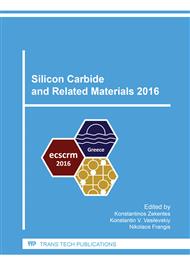p.525
p.529
p.533
p.537
p.541
p.545
p.549
p.553
p.557
Analysis Self-Healing of Gate Leakage Current due to Oxide Traps to Improve Reliability of Gate Electrode
Abstract:
To achieve robust SiC-MOSFET, reliability of the gate insulator was investigated in terms of gate electrode edge treatment. Analytical calculation showed that r should be larger than the thickness of gate insulator to relax the electric field concentration. We obtained the rounded gate edge by dry oxidation at 1000°C, while oxidation at 800°C had it sharpened. Former samples exhibited low leakage current with Time-Zero-Dielectric-Breakdown (TZDB) measurement. Ig consisted of Fowler-Nordheim (FN) tunneling current for Vg > 0, and it includes excess components for Vg < 0. We confirmed that they occurred at the gate edge and that they coursed positively charged trap centers in oxide near poly-Si/SiO2 interface which caused local barrier lowering. Electron injection removed them by tunneling/recombination process, which followed tunneling-front model.
Info:
Periodical:
Pages:
541-544
Citation:
Online since:
May 2017
Authors:
Keywords:
Price:
Сopyright:
© 2017 Trans Tech Publications Ltd. All Rights Reserved
Share:
Citation:


